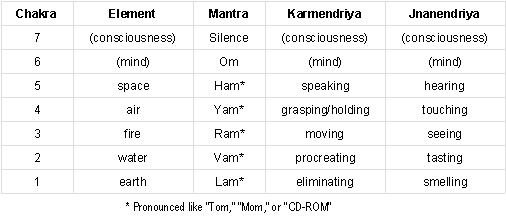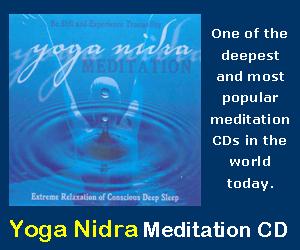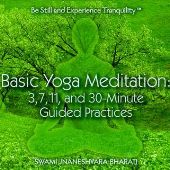|
|
Chakra Meditation
Bhuta Shuddhi
Purifying the 5 Elements
by
Swami Jnaneshvara Bharati
SwamiJ.com

Bhuta Shuddi is an ancient Chakra Meditation
of Yoga and Tantra practice through which
the five elements (bhutas) are balanced or purified (shuddhi). Bhuta
refers to the past, and shuddhi refers to purifying that past, or the
samskaras that operate in conjunction with the five elements. This is a very useful practice, whether you think
of it as preparation for kundalini
awakening, or simply as a practice
for feeling balanced, centered, or tranquil, etc. (One of
the two foundations of Yoga is Abhyasa, practices seeking of
tranquility; Yoga Sutras
1.12-1.14).
For the Chakra Meditation of Bhuta
Shuddhi, it is necessary to understand how the five elements relate to
the chakras. The five bhutas are the five elements of earth,
water, fire, air, and space, and they operate in conjunction with the
lower five chakras (at subtle level they are called tanmatras, which are
part of tattvas, or subtle constituents). The sixth
chakra is of mind, and is beyond or prior to the bursting forth of
space, air, fire, water, and finally earth. Consciousness itself (or
whatever you want to call it) is prior to, or the source of
manifestation of mind, and is the seventh chakra (surely there are other
chakras, including between sixth and seventh, but the bhuta shuddhi
practice itself need not focus directly on these).
Sound file of the bija mantras
Click here to download
an 2:55 minute mp3 recording of the bija mantras for the chakra.
Two series of repetitions are there for each of the chakras. The
recording systematically moves from the base chakra up to the
crown, and the reverses, going back down to the root chakra.
Then you might enjoy simply breathing up and down the sushumna
channel, the subtle spine, either with Om going up and down, or
Sohum, with So going up to the crown and Hum going down to the
base of the spine.
Alignment
of the five elements
The five elements align with, and
operate from the five lower chakras, along with the ten indriyas
and a seed mantra for each. In systematic Chakra Meditation, you
progressively move attention through the chakras, along with
awareness of the nature of each chakra.

Method
of practicing Chakra Meditation - Bhuta Shuddhi
There may be many methods of purifying
the five elements, ranging from meditative practices (including
Yoga
Nidra) to various forms of
ritualistic practices. With some reflection it makes sense how it is
that many practices might have such an effect. The Chakra Meditation method
presented below (Bhuta Shuddhi) works directly with attention on the chakras, balancing
the subtle forces of the five elements through the use of the bija
(seed) mantras of the chakras.
Before doing the Chakra Meditation - Bhuta Shuddhi practice
itself, it is useful to do some some stretches or hatha asanas
(postures) followed by some form of physical relaxation
exercise, such as a complete
relaxation. This helps prepare the mind to be able to focus on the
chakras.
Chakra Meditation - Bhuta Shuddhi:
Sequentially move through the chakras in the following sequence.
As you read this, please keep in mind that reading about the
practice is more difficult than doing the practice. The
descriptions are lengthy, but the practices actually
straightforward and simple.
-
Muladhara Chakra Meditation: Bring your
attention to the perineum, the flat space between the anus and the
genital area. Take several seconds to allow your attention to find
the space, and to get settled into it. Allow the mantra Lam
to arise repeatedly in your mind field, silently. Allow it to repeat
at its own natural speed. You may find that it comes 5-10 times and
wants to pause, or you might find it wants to come continuously. If
it pauses, allow it to return in its own time. The mantra may move
quickly or slowly. In any case, keep your attention on that space;
this is very important. That space might be tiny, such as a
pinpoint, or it might be several inches across. Follow your own
inclination about the size of the space. Allow your mind to
naturally be aware of earth, solidity, or form. That awareness may
come a little or a lot; either way is okay. Allow to come through
your mind field the awareness of of the karmendriya of elimination
(which operates throughout the body), and the jnanendriya of smell
(best to become familiar with the nature of the indriyas).
Gradually, over time with the practice, it becomes more clear how it
is that the indriyas operate from these centers, along with the five
elements. You may or may not also find that colors and sounds
naturally come to the inner field of mind.
-
Svadhistana Chakra Meditation: When you move
your attention upwards towards the second chakra, be mindful of the
transition, of the motion of attention and the nature of the shift
of energetic, emotional, and mental experience. Allow your attention
to naturally find the location of the second chakra. Your own
attention will find, and settle into that space. It is important to
note that the actual chakra is in the back, along the subtle spine
called sushumna, although we usually experience it in the front.
Allow the attention to rest where it naturally falls, probably in
the front, but be mindful from time to time that the chakra is
actually in the back. Gradually attention will find this central
stream running up and down through all of the chakras (sushumna
is actually subtler than the chakras). Allow the mantra Vam
to arise and repeat itself, at its own speed, naturally coming and
going. Hold your attention in the space, whether a pinpoint or a few
inches across. Allow the awareness of water to arise, and come to
see how this has to do with allow forms of flow or fluidity, whether
relating to energy, physical, emotional, or mental. Explore the
awareness of the karmendriya of procreation and the jnanendriya of
tasting (once again, become familiar with the indriyas).
Again, colors or sounds may or may not come and go.
-
Manipura Chakra Meditation: Be aware of the
transition as you move to the third chakra, at the navel center,
which is also actually along the sushumna channel. Allow the mantra Ram
to arise and repeat itself, at its natural speed. Keep attention in
the space, whatever size at which it is experienced. Be aware of the
element of fire, and the many ways in which it operates throughout
the gross and subtle body from this center. Be aware of the
karmendriya of motion, and how motion itself happens in so many
physical, energetic, and mental ways. Be aware of the jnanendriya of
seeing, which you will easily see as related to fire and motion.
Colors and sounds may or may not come and go.
-
Anahata Chakra Meditation: Observe the
transition as you move your attention to the fourth chakra, the
space between the breasts. Allow attention to become well seated
there, and then remember the vibration of the mantra Yam,
allowing it to repeat at its own speed, while being mindful of the
feeling it generates. Be aware of the element of air, and notice how
that feels with the mantra. Notice how the element of air relates to
the the karmendriya of holding or grasping, whether physically,
energetically, mentally, or emotionally. Observe how these relate to
the jnanendriya of touching, and how that touching is very subtle in
addition to being a physical phenomenon. Colors and sounds may come
and go.
-
Visshuda Chakra Meditation: Bring your
attention to the space at the throat, the fifth chakra, which is the
point of emergence of space (which allows air, fire, water, and
earth to then emerge). In that space, be aware of the nature of
space itself, allowing the mantra Ham to arise and
repeat itself, reverberating many times through the seemingly empty
space in the inner world (a space that is really not empty, but is
of potential). Awareness of the karmendriya of speech (actually,
communication of any subtle form) is allowed to be there,
experiencing how that vibrates through space. The jnanendriya of
hearing is allowed to come, also seeing how it naturally aligns with
space, speech, and the vibration of mantra. Notice the fine, subtle
feelings, which come with the experience. Colors or sounds are
allowed to come and go, if they happen to arise.
-
Ajna Chakra Meditation: Gently, with full
awareness, transition awareness to the seat of mind at the space
between the eyebrows, ajna chakra. Allow the mantra OM
to arise and repeat itself, over and over, as slow waves of mantra,
or as vibrations repeating so fast that the many OMs merge into a
continuous vibration. Be aware of how mind has no elements, but is
the source out of which space, air, fire, water, and earth emerge.
Be aware of how this space, this mind, itself, does no actions, but
is the driving force of all of the karmendriyas of speech, holding,
moving, procreating, and eliminating. Be aware of how this chakra,
this mind, has no senses itself, but is the recipient of all of the
information coming from hearing, touching, seeing, tasting, and
smelling, whether the source of this input is the sensations from
the external world, coming through the physical instruments, or
coming from the inner world of memories or subtle experience,
presenting on the mental screen through the subtle senses.
Gradually, come to see how OM mantra is
experienced as the source or map of manifestation itself. Many
senses, images, or impressions may come and go, but they are let go,
as attention rests in the knowing beyond all senses, in the ajna
chakra and the vibration of OM.
-
Sahasrara Chakra Meditation: Allow attention to
move to the crown chakra, which has no element (bhutas), no cognitive
sense (jnanendriyas), no
active means of expression (karmendriyas), as it is the doorway to pure
consciousness itself. Experience how this is the source out of which mind emerges, after
which emerge the five elements, the five cognitive senses, and the five
means of expression. The “mantra” (in its subtler, silent form) is that
silence (not mere quiet) out of which the rest have emerged. It is
experienced as the silence after a single OM, merging
into objectless, sense-less awareness. Allow attention to rest in
that pure stillness, the emptiness that is not empty, which
contains, and is, the pure potential for manifestion, which has not
manifested.
-
Ajna Chakra Meditation: Briefly bring your
attention back to the sixth chakra, allowing the vibration of OM
to return, which starts the journey of attention back into the body
and world. A few seconds, 30 seconds, or maybe a minute should be
comfortable, though it may be longer if you wish.
-
Visshuda Chakra Meditation: Bring your
attention down to the fifth chakra, the throat, remembering Ham,
as you enter into the realm of space, hearing, and speaking. Again,
a few seconds or a minute is good.
-
Anahata Chakra Meditation: Transition to the
fourth chakra, the heart, as you allow the mantra Yam
to arise, remembering the element of air. Awareness of holding and
touching may or may not arise.
-
Manipura Chakra Meditation: Be aware of the
third chakra, the navel center, and the vibration of Ram,
along with the element of fire, with awareness of motion and seeing
coming or not coming.
-
Svadhistana Chakra Meditation: Bring your
attention to the second chakra, and allow the vibration of the
mantra Vam to arise and repeat itself, remembering the
element of water, with awareness of procreation and tasting coming
or not coming.
-
Muladhara Chakra Meditation: Transition
attention back to the first chakra, at the perineum, allowing the
mantra Lam to come.
When first
practicing Chakra Meditation of Bhuta Shuddhi, it can seem confusing to keep track of
mantras, elements, senses, and actions. To make this Chakra Meditation easy, the two keys
to emphasize initially are: 1) keeping attention in the space, and
2) remembering the vibration in the mantra (it won't take very long to
memorize which mantra goes with which chakra). Then allow the rest to
gradually come in time. Both the balancing of the elements (and chakras)
and the many insights will come over time, with practice.
After the Practice: After the Chakra Meditation - Bhuta Shuddhi practice
itself, it is best to then do some more meditation practice (since mind
is now quite prepared). One good thing to do first is to practice spinal
breath, where you bring your attention upwards to the crown with
inhalation, and then follow the stream of the subtle spine down to the
first chakra with exhalation. This is nicely done with soham
mantra, where you inhale up with Soooo and exhale down with Hummm.
This can then be followed by your regular meditation, allowing your
attention to rest in only one of the chakras, the one where you
regularly place attention during meditation, or the place that feels
most comfortable.
Complete
practice based on Chakra Meditation
The Chakra Meditation - Bhuta Shuddhi practice can be
practiced alone or as a part of a complete meditation practice. Here is
one way to do this, which can be adapted to match personal inclinations.
This example is a 60-minute practice.
-
15 minutes of Hatha: Practice some
hatha Yoga postures (asanas) or simple stretches, along with some
breathing practices (pranayama). Obviously the times can be much
longer, or might even be less. You might want to also experiment
with doing some more vigorous physical exercise before doing the
postures and breathing, such as walking, jogging, swimming,
bicycling, or working out with some exercise routine.
-
30 minutes of Chakra Meditation: If you move
upwards through the seven chakras, allowing 3-4 minutes for each
chakra, and then downwards through the seven chakras, allowing about
30 seconds each (to bring you back to being grounded), the total
Bhuta Shuddhi practice itself will be about 30 minutes.
-
15 minutes of Meditation: Then do your
regular meditation practice, whatever that may be, such as bringing
your attention deeply into the space between the breasts (anahata
chakra) or the space between the eyebrows (ajna chakra), with or
without mantra or your regular object of meditation.
Honoring
your capacity
As with all practices, it is best to be
aware of, and honor your capacity. The example above is 30 minutes of
Chakra Meditation - Bhuta Shuddhi, and 60 minutes in total. For some, this might seem like a
short time. For others, it might seem like a long time. Practicing
within your comfort level is far more useful than trying to strive for
any goal. If you find a complete practice of 10 minutes serves you, then
this is the right amount of time. Actually, it can be quite useful to
simply move through the awareness of the chakras (up, then down) in a
matter of a couple minutes, remembering the mantras along the way. Even
a brief practice of Chakra Meditation of 30 seconds to 1 minute is quite pleasant and useful,
and can be done often.
Home Top

-------
This site is devoted to
presenting the ancient Self-Realization path of
the Tradition of the Himalayan masters
in simple, understandable and beneficial ways, while not compromising
quality or depth. The goal of our sadhana or practices is the highest
Joy that comes from the Realization in direct experience of the
center of consciousness, the Self, the Atman or Purusha, which is
one and the same with the Absolute Reality.
This Self-Realization comes through Yoga meditation of the Yoga
Sutras, the contemplative insight of Advaita Vedanta, and the
intense devotion of Samaya Sri Vidya Tantra, the three of which
complement one another like fingers on a hand.
We employ the classical approaches of Raja, Jnana, Karma, and Bhakti
Yoga, as well as Hatha, Kriya, Kundalini, Laya, Mantra, Nada, Siddha,
and Tantra Yoga. Meditation, contemplation, mantra and prayer
finally converge into a unified force directed towards the final
stage, piercing the pearl of wisdom called bindu, leading to the
Absolute.
|
|


